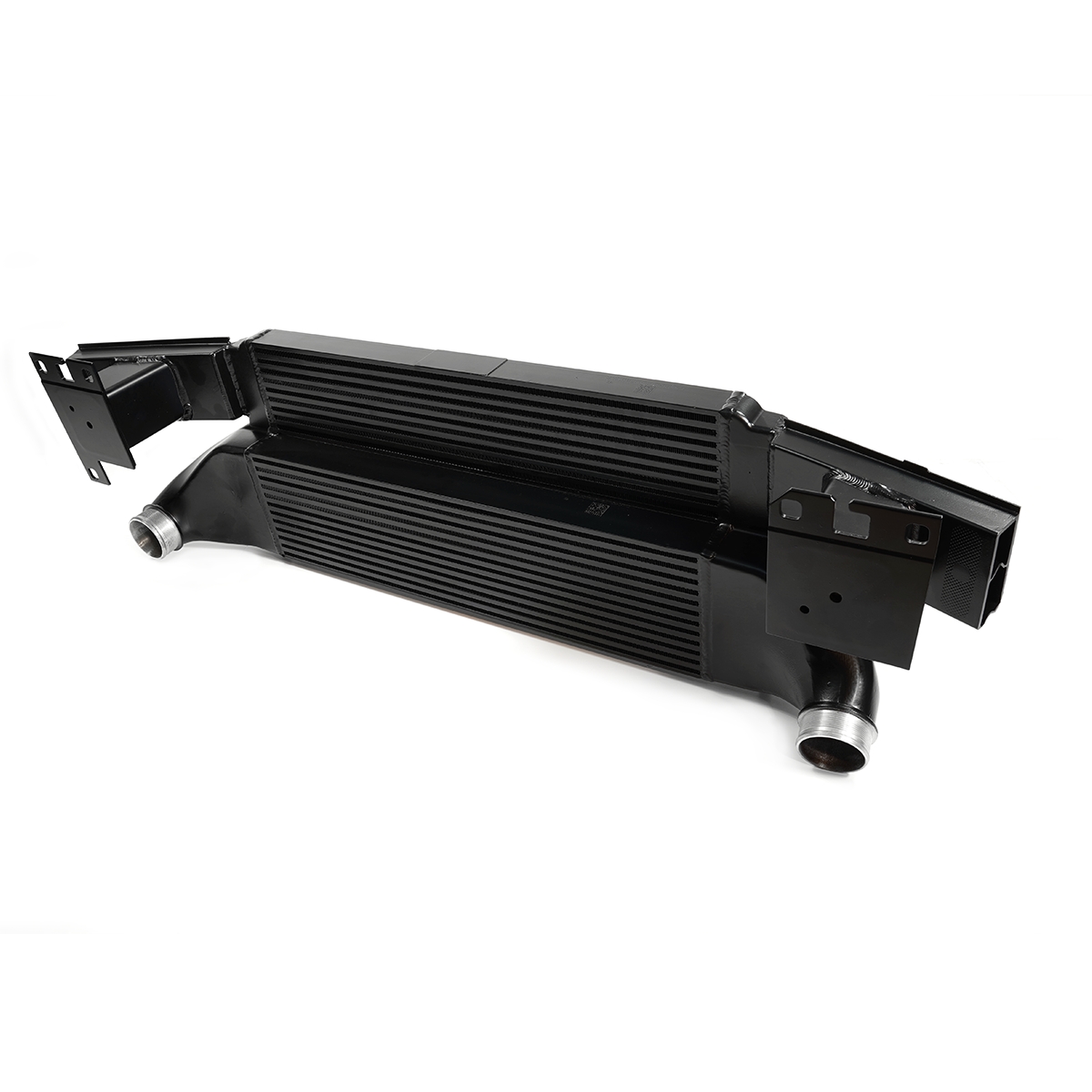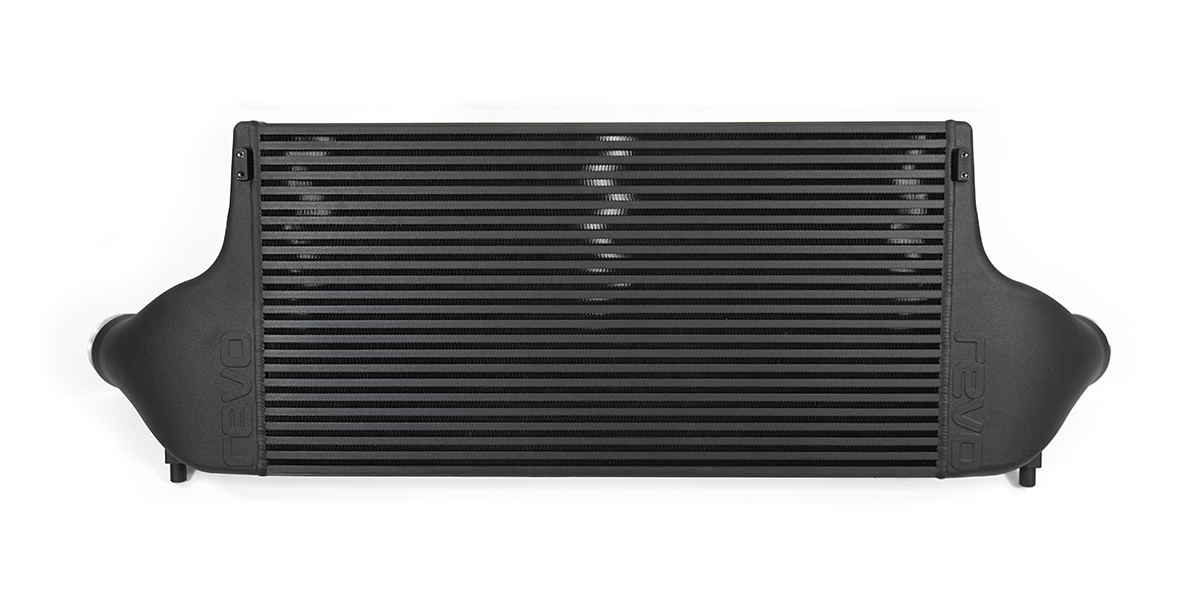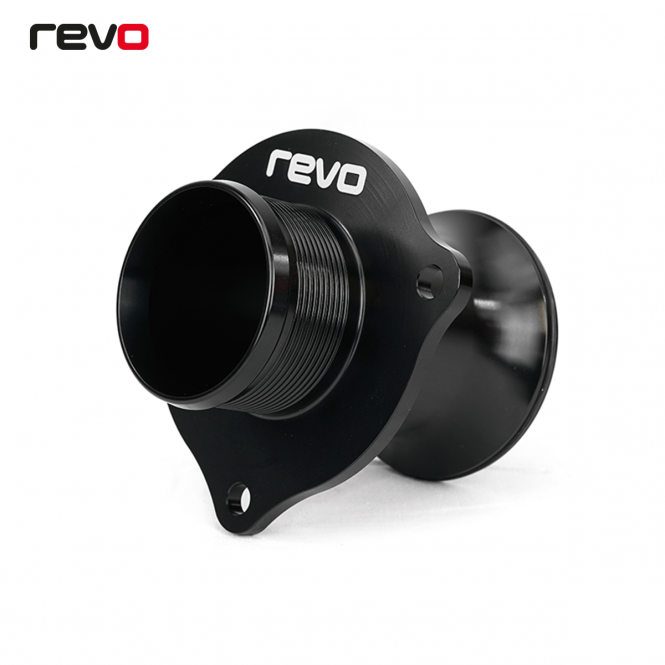Revo Ladeluftsysteme

REVO LADELUFTKÜHLERAUDI TTRS 8S 2.5TFSIDer Revo Ladeluftkühler nutzt einzigartige Konstruktionsmerkmale um die Ansauglufttemperatur so gering wie möglich zu halten. Dies geschieht im Einklang mit minimalem Druckabfall um dem Motor ein maximalen Benefit in Sachen Leistung und Drehmoment zu ermöglichen über den gesamten Drehzahlbereich. Die Endtanks wurden speziell entwickelt, um die interne laminare Strömung zu verbessern, die internen Turbolenzen zu verringern und den Durchfluss zu beschleunigen. Der Ladeluftkühler arbeitet dadurch natürlich hocheffizient und perfekt in Kombination mit allen Revo Softwareständen.Der serienmäßige Ladeluftkühler zeigte deutliche Schwächen während der Eingangstests, sowohl bei den Prüfstandsläufen als auch bei den Tests im normalen Straßenverkehr. Im Vergleich mit dem original Bauteil, wurde die Ansaugtemperatur um bis zu 55°C verringert. Damit behält der Motor stets seine maximale Performance, auch wenn es heiß her geht.DIE WICHTIGSTEN MERKMALE AUF EINEM BLICKBar & Plate Core DesignAluminium Guss EndtanksP&P Bauteil mit integrierter CrashbarBoostpipekit mit WMI Anschluss im Lieferumfang80% mehr LuftvolumenBis zu 55°C geringere Ansauglufttemperatur80% MEHR VOLUMENDer Revo Ladeluftkühler wurde nach einem einfachen Prinzip entwickelt: Es wird so viel Volumen zur Verfügung gestellt, wie benötigt wird. Der von Grund auf neu konstruierte Revo Ladeluftkühler überzeugt mit 80%* mehr Volumen (*im Vergleich zum original Bauteil). Der Integrierte Prallträger ermöglicht hierbei die maximal mögliche Kühlfläche.ENDTANK DESIGNDie serienmäßigen Endtanks des 2.5 TSI Motors sind im Prizip wie jeder OE Ladeluftkühler aufgebaut. Das Aluminiumnetz wird von 2 Kunststofftanks eingefasst. Der Revo Ladeluftkühler bietet hier durch das einzigartige Design die größtmögliche Querschnittsströmungsfläche bei optimalen Strömungsgeschwindigkeiten. Die gegossenen Aluminiumendtanks bestechen durch eine extrem glatte Oberfläche, die maßgeblich zur Leistungssteigerung beiträgt. Das Gleichgewicht zwischen Strömungsgeschwindigkeit, Druckverlust und Kühlung wurde hier in Einklang gebracht.DAS KÜHLNETZ DES LADELUFTKÜHLERSDas besondere Bar&Plate Netz liefert hier eine besonders effektive Wärmeableitung, der Druckverlust ist durch diese Bauweise des Kühlnetzes minimal. Der Revo Ladeluftkühler ist zudem ausgestattet mit einer sorfältig ausgewählten Lamellengeometrie, um zusätzlich die Wärme perfekt abgeben zu können. Es kommen 2 verschiedene Lamellenarten zum Einsatz. Die Umgebungskernseite verwendet Lamellenrippen, um den Umgebungsluftstrom zu verlangsamen, wodurch die Wärmeübertragung verbessert wird, während die Ladungskernseite ein versetztes Innenrippen-Design aufweist, um die Oberfläche und den Luftwiderstand auszugleichen und den Druckabfall zu minimieren. INTEGRIERTER PRALLTRÄGERUm das Grundvolumen des Ladeluftkühlers maximal zu vergrößern, wurde hier der Ladeluftkühler in den Prallträger integriert. Durch die zusätzlichen Versteifungen im Übergang zum Kühler wurde der Sicherhietsfaktor nochmals erhöht. Dadurch wird der Kühler nicht nur perfekt in Position gehalten, sondern verbessert auch die Festigkeit. Das Bauteil kann perfekt an den original Schraubpunkten befestigt werden.BOOSTPIPEKITEin Highlight des neuen Revo Ladeluftkühlers ist ohne Zweifel das Boostpipekit. Das Pulverbeschichtete Aluminium Rohr samt 6-lagigen Silikonschläuchen mit stoßkantenoptimierten Übergängen erhöhen das Volumen um 27%* (ImVergleich zu den OE-Bauteilen). Das Flush-Fit Design sorgt hier mit den sanften Übergängen für optimalen Flow mit minimalen Verwirbelungen.FORSCHUNG UND ENTWICKLUNGAlle Revo-Produkte werden intern mit der neusten 3D-Drucktechnologie, CAD und CFD Software Entwickelt. Jedes Produkt wird mit einem internen HUB-Dyno und der hauseigenen Revo-Datenerfassungsoftware streng kontrolliert. Der Revo Ladeluftkühler minimiert Luftverwirbelungen und maximiert die Wärmeableitung. Die kühle Ansauglufttemperatur in Verbindung mit dem geringen Druckverlust steigert hier die Leistung und das Drehmoment über den gesamten Drehzahlbereich. Der Benefit wurde mit dem HUB-Dyno unter gleichbleibenden Randbedingungen getestet.Beim Vergleich mit dem Serienladeluftkühler wurde der Revo TT RS mit Milltek Downpipe, Revo Carbon Intake sowie der Revo Stage 2 Beta Software ausgestattet. In einem Back to Back Test mit dem Revo Ladeluftkühler wurden bei gleichen Starbedingungen die Unterschiede in der Leistung deutlich darzustellen.LEISTUNGSDATENDer Revo Ladeluftkühler wurde in einem Back to Back Test mit dem OEM-TT RS Ladeluftkühler verglichen. Mit Spitzenwerten von +40PS/+41nm sowie Leistungs und Drehmomentanstieg über den gesamten Drehzahlbereich, wurde sein Benefit deutlich sichtbar. ANSAUGLUFTTEMPERATUR NACH LADELUFTKÜHLERIm Diagramm zu sehen ist der deutliche Unterschied OE vs. Revo. Der Revo TT RS 8S Ladeluftkühler übertrifft hier alle bisherigen Entwicklungen. Im Diagramm werden 6 aufeinanderfolgende Prüfstandsläufe im Direkten Gang dargestellt. Der Revo Ladeluftkühler kühlte die Ansauglufttemperatur hierbei zwischen 57,4°C und 17,5°C mehr, als das Serienbauteil. DRUCKVERLUST - DAS GEHEIMNIS EINES GUTEN LADELUFTKÜHLERSDer Druckverlust ist ein wichtier Fakrtor bei der Auswahl eines Ladeluftkühlers. Der Revo Ladeluftkühler ist hier mit speziell entwickelten Endtanks ausgestattet, um den Druck gleichmäßig auf das Kühlnetz zu verteilen. Die Grafik zeigt, dass selbst durch den massiven Anstieg des Volumens im vergleich zum Serien Ladeluftkühler, lediglich ein Druckabfall von 0.23psi (0,016bar) realisiert wurde. Dies ist besonders wichtig in Sachen Ansprechverhalten. Ein zusätzliches Turbo-Lag durch die pure Größe des Ladeluftkühlers ist hier kein Thema. Der Wagen fährt selbst mit Stage 2 wie ein serienmäßiger TT RS 8S, bis man das Pedal drückt und die Stage 2 sein volles Potenizal freisetzt.DER LADELUFTKÜHLER IST PASSEND FÜR FOLGENDE FAHRZEUGEHerstellerModellMotorBaujahrAudiTTRS2.5 TFSI2017-

REVO LADELUFTKÜHLERFORD FIESTA ST MK8 1.5 ECOBOOSTDer Revo Ladeluftkühler für den Ford Fiesta Mk8 verfügt über ein einzigartiges Design, dass es ihm ermöglicht, Druckabfall zu minimieren und gleichzeitig die Ladeluft zu kühlen und Leistung sowie Drehmoment zu steigern.Der aufgeladene 4 Zylinder Motor vom Fiesta erzeugt Ansaugtemperaturen, bei denen der originale Ladeluftkühler Probleme hat mitzuhalten. Der Revo Intercooler bekämpft das, indem er statt dem OEM Teil montiert wird und die Ladedrucktemperatur um bis zu 40° senkt. Dies ermöglicht es dem Motor mehr Leistung über einen längeren Zeitraum zu produzieren.KEY FEATURESBar & Plate Core Design18.5% größere Kühlfläche72.4% größeres Volumen des LadeluftkühlersÜber 40ºC geringere LadeluftthemperaturVergrößertes KühlervolumenDer Revo Ladeluftkühler wurde nach einer simplem Divise gebaut; einen Kühler entwerfen, der mit ihren Leistungsansprüchen mithalten kann. Von Grund auf neu entworfen hat der Revo-Ladeluftkühler ein 38% höheres Fassungsvermögen als der originale Ladeluftkühler zudem bietet er einen perfekten Sitz im Motorraum, indem der ungenutzte Platz hinter der Crash Bar verwendet wird.72.4% mehr Fassungsvermögen des Ladeluftkühlers18.5% größere AnströmflächeEND TANK DESIGNDas Design der Endtanks des Revo-Ladeluftkühlers ermöglicht maximalen Luftfluss durch den Kühler. Durch die glatte, aus Aluminium gegossene Oberfläche im Inneren des Kühlers wird das ungehinderte fließen von Ladeluft gewährleistet. Die Endtanks spielen auch beim Erhalten des Ladedrucks eine wichtige Rolle und sind genau darauf abgestimmt.BAR AND PLATEAusgestattet mit einem „BAR & PLATE“ Kern zur Maximierung des Hitzeausgleichs entsteht innerhalb des Ladeluftkühlers weniger Reibung als bei der „TUBE & FINS“ Alternative. Die Reibung innerhalb des Kühlers wird außerdem durch die spezifizierte Geometrie der Finnen gering gehalten.RESEARCH AND DEVELOPMENTAlle Revo Produkte werden unter einem Dach entworfen. Hierbei wird die neuste 3D Druck Technik in Kombination mit CAD und CFD Software verwendet. Jedes Produkt wird rigoros auf dem eigenen Leistungsprüfstand mit der Revo Datenerfassungssoftware getestet. Der Revo Ladeluftkühler minimiert Turbulenzen und maximiert gleichzeitig den Hitzeaustausch, was zu niedrigeren Ladelufttemperaturen und einem geringeren Druckabfall führt. Das hilft, Leistung und Drehmoment im gesamten Drehzahlbereich zu verbessern was auch die kontrollierten Tests auf dem Leistungsprüfstand zeigten.Der Revo Focus RS Ladeluftkühler wurde bei Revo getestet. Bei dem Test wurde ein Auto mit Miltek Downpipe und Revo Stage 2 Software. Der Diagramme unten bilden den Lauf mit Serien-Ladeluftkühler und mit dem Revo Ladeluftkühler ab.OUTLET TEMPERATUREDas folgende Diagramm dient als Testergebnis der beiden Ladeluftkühler am Fiesta ST. Die zwei Graphen zeigen aber einen enormen Unterschied zwischen dem Originalteil und dem Revo Kühler. Hier zu erkennen ist, dass der Revo Kühler die Ladeluft nicht nur stärker abkühlt, sondern auch über einen längeren Zeitraum die konstant niedrigen Temperaturen beibehalten werden. Der Revo Ladeluftkühler übertrifft die Ergebnisse des Originals deutlich und erweist sich als extrem resistent gegen Erhitzung .Man könnte 10 weitere Läufe auf dem Leistungsprüfstand machen, ohne sich Gedanken über die Ladelufttemperatur machen zu müssen. Das Upgrade auf den Revo Kühler brachte eine beeindruckende Verringerung der Ansaugtemperatur von 34°C in der Spitze und 12°C im Durchschnitt.INTERCOOLER PRESSURE DROP GRAPHDas folgende Diagramm dient als Testergebnis der beiden Ladeluftkühler am RS3 8v.2 2.5TFSI. Die zwei Graphen zeigen aber einen enormen Unterschied zwischen dem Originalteil und dem Revo Kühler. Hier zu erkennen ist, dass der Revo Kühler die Ladeluft nicht nur stärker abkühlt, sondern auch über einen längeren Zeitraum die konstant niedrigen Temperaturen beibehalten werden. Der Revo Ladeluftkühler übertrifft die Ergebnisse des Originals deutlich und erweist sich als extrem resistent gegen Erhitzung .Man könnte 10 weitere Läufe auf dem Leistungsprüfstand machen, ohne sich Gedanken über die Ladelufttemperatur machen zu müssen. Das Upgrade auf den Revo Kühler brachte eine beeindruckende Verringerung der Ansaugtemperatur von 38.2°C in der Spitze und 18.23°C im Durchschnitt.LADELUFTKÜHLER DRUCKABFALL GRAPHDruckabfall ist ein wichtiger Faktor bei der Auswahl des passendes Ladeluftkühlers. Die Aluminium-Guss-Endtanks des Revo Ladeluftkühlers ermöglichen eine gleichmäßige Verteilung der Ladeluft im Kern. Die Graphik zeigt einen Druckabfall von nur 0.11psi, obwohl der Revo Ladeluftkühler um einiges größer ist. Der sehr geringe Druckabfall sorgt für ein besseres Ansprechverhalten des Motors, sowie eine Minimierung des Turbo Lochs.

Turbo Muffler Delete_________________________________________ Der Revo Turbo Muffler Delete wurde entwickelt und hergestellt, um den serienmäßigen Schalldämpfer in Fahrzeugen mit 2.0T TSI/TFSI EA888 EVO Motoren mit Garrett Turbo direkt zu ersetzen. Der Revo Turbo Muffler Delete bietet einen hochwertigen einteiligen Ersatz für das OEM-Teil, der einen gleichmäßigeren, ununterbrochenen Luftstrom und eine verbesserte Gas- und Schubreaktion ermöglicht. Hauptmerkmale_________________________________________ • CNC-gefräst• Weicherer Luftstromübergang• CAD-Design für optimale Passform• Verbesserte Boost-Reaktion OEM-TEIL_________________________________________ Der werksseitige Garrett-Turbolader Ihres Motors ist mit einem Turboschalldämpfer ausgestattet, der am Kompressor Ausgang positioniert ist. Dies wurde entwickelt, um das Geräusch des Turboladers zu reduzieren, indem mehrere Löcher in die Seitenwände geschnitten werden, die Kammern bilden. Diese Kammern verursachen Turbulenzen in der aus dem Turbo austretenden Luft, die einen Gegendruck erzeugen, der sich negativ auf Leistung und Reaktion auswirkt. DESIGN-MERKMALE_________________________________________ Der von Revo entworfene Turbo-Schalldämpfer ist aus einem einzigen Stück Billet-Aluminium CNC-gefräst und für Festigkeit und Korrosionsbeständigkeit schwarz eloxiert mit einem lasergeätzten Revo-Logo. Sein einteiliges Design ermöglicht der Luft einen direkteren Weg beim Austritt aus dem Turbo, glättet den Luftstrom und bietet eine verbesserte Gas- und Schubreaktion. Dieses Teil wird komplett mit einem Hochtemperatur-O-Ring geliefert, um eine sichere Abdichtung beim Einbau zu gewährleisten. FAHRZEUGANWENDUNGEN _________________________________________ Hersteller Modell Motor Motor Code Baujahr Audi Q3 (F3) 45 TFSI DNPA 2019 > Audi TT (FV) 45 TFSI DNPA 2021 > CUPRA Leon (KL) 2.0 TFSI DNPA 2020 > SEAT Tarraco (KN) 2.0 TFSI DNPA 2021 > SEAT Formentor 2.0 TFSI DNPA 2021 > Skoda Octavia (NX) 2.0 TSI DNPA 2020 > VW Golf GTI (MK8) 2.0 TSI DNPA/DRNA 2020 > VW Tiguan (AD/AX) 2.0 TSI DNPA 2021 > * Nur für 2.0T EA888 Evo Motoren mit Garrett Turbos. Bitte beachten Sie, dass der Golf R Mk8 & S3 (8Y) und andere 2.0T 300-320PS Modelle einen anderen OEM Turbolader haben. Dieser Artikel ist nicht für die Nutzung im öffentlichen Straßenverkehr zulässig - Einsatz nur für Rennsportzwecke !
